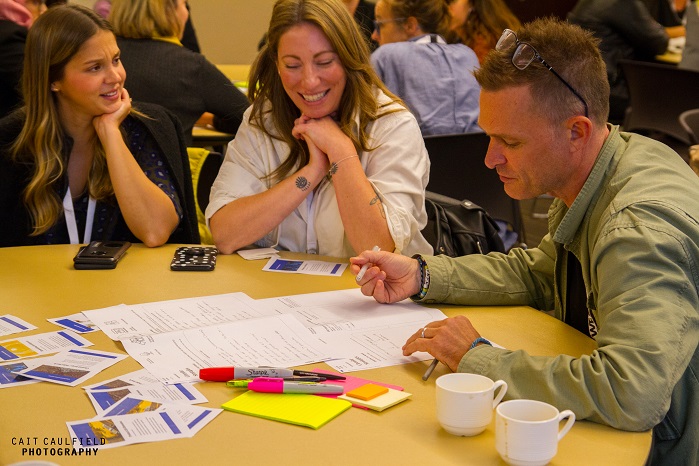
TrusTrace updates solution for forced labour prevention
Opinion


At the conference, the organisers Fashion Takes Action joined forces with PwC to launch the Sustainable Fashion Toolkit.

29th October 2019
Marie O'Mahony
|
Toronto
 It may seem churlish to complain about an abundance of information, but for many in the apparel and textiles industry the vast quantity of data currently available on sustainability is daunting to navigate. This is particularly the case for new entrants and SMEs who rather than risk doing the wrong thing elect to wait for greater certainty.
It may seem churlish to complain about an abundance of information, but for many in the apparel and textiles industry the vast quantity of data currently available on sustainability is daunting to navigate. This is particularly the case for new entrants and SMEs who rather than risk doing the wrong thing elect to wait for greater certainty.
At the World Ethical Apparel Roundtable (WEAR2019) conference held from 7-19 October 2019 in Toronto, the organisers Fashion Takes Action joined forces with PwC to launch the Sustainable Fashion Toolkit. Available free initially on the internet, it brings together curated content where resources are centrally located, easy and quick to navigate. Designed for all levels of knowledge, size of business and across the value chain, the initial reception at the conference was enthusiastic.
Measurement was a key theme of the conference as Janice Noronha, PwC Canada noted that “GDP is just on component in valuing, we need to move to a broader form of measurement.” Noronha is a partner within the Risks Assurance Services of PwC Montreal, specialising in Sustainability and Climate Change Practise. She continued to point out that 99% of sustainability reports today sit in the measurement column and these she believes need to move along to the next column that looks at what is valued.
Governments she sees doing this but not manufacturers. Not yet. Water was given as an example of how a resource or commodity is valued differently, comparing its price in Canada a country that boasts over 20% of the world’s surface freshwater, while Australia experiences regular and often extended periods of shortage such as the ‘millennium drought’ (2000-2010).
“In 1996 when the photo emerged of a child stitching a [branded] soccer ball there was no way for Nike to know” according to Leonard Bonanni, “now there is no excuse for them not to know”. Bonanni is Founder and CEO of Sourcemap, a software company that is dedicated to supply chain transparency with clients that include the VF Corporation.

Integrating sustainability into retail operations panel discussion (l. to r.) Jessica Iida, Lululemon; Anika Kozlowski, Ryerson University; Karine Kicak, Aldo Group; Mike Newman, Returnity. © Marie O’Mahony
The growth of companies like Sourcemap is indicative of the complexity inherent in managing a supply chain that can span continents. It also points to consumer cynicism around ‘green washing’ and the demand this has created for data that is itself transparent and verifiable. Suppliers are realising the market value of transparency without it the premium contracts will go elsewhere. For the brands themselves Bonanni points to an additional benefit in attracting the best talent as he puts it “who doesn't want to work for a company that knows what it’s doing!”
Tara Vassefi is a former human rights lawyer and currently the Director of Strategic Iniatives at Truepic, a technology company that specialises in image authentication for accountability and justice. The ubiquitous smartphone provides a platform for Truepic’s capability. The first step collects photos and video from user’s own phones that are then downloaded on an app. This is then subjected to digital forensics for authentication. Verifying the pixel data involves a reverse image test to check that it is in fact a 3D rather than 2D image – not a photo of a photo in other words. “We want to close trust gaps with images and videos,” explains Vassefi continuing “Blockchain to me was the only technology that could close that gap.”

Amanda Cosco, Electric Runway interviewing Mikhal Damiani, co-founder and CEO, Blue Bite. © Marie O’Mahony
Retail iniatives extended from discussion on bricks and mortar or e-commerce. The Aldo Group’s Karine Kicak described the 45-year old brand’s Corporate Social Responsibility aims and objectives with a global reach across over a hundred countries. The introduction a carbon footprint measurement process in 2013 has been used as a baseline for improvement across their own emissions and those of their partners achieving a 46% reduction of their own operational emissions by 2018 to become carbon neutral. This was achieved through a combination of reduction, replacement and offsetting.
An estimated 30-40% of online sales are returned. This is not simply because of poor size or fit. One trend amongst the Instagram generation is to buy online, photograph themselves in the new clothing and footwear then return it. So how does e-commerce go about changing this? “74% of Americans prioritise experience over product”, according to Mikhal Damiani, co-founder and CEO of Blue Bite, a B2B software platform that connects brands with consumers with clients that includes Adidas and Spyder.
Interviewed by Electric Runway’s Amanda Cosco the discussion focus was on e-commerce. Indicative of the way that sustainability is moving away from conventional swing tag approach, the discussion centred around building consumer awareness and engagement through the experiences afforded by storytelling and gamification. Using NFC or QR codes, consumers can easily access and activate experiences that start with their product purchase and extend to their mobile phone. Layers build and connect including capability such as product authentication and exclusive content.

Breakout session at WEAR 2019. © Cait Caulfield for Fashion Takes Action
Damiani describes the company as “enablers, it has to come from the brands and it’s really up to them to come to us with creative ideas”. During Q+A delegates had their own creative ideas of how the platform might be used from facilitating a brand shift from product to service/experience, to embedding a storytelling and authentication narrative in thrift store clothing and footwear.
As with all aspects of fashion and footwear the issue of sustainability and how to address it, embed it in the brand or product is changing rapidly. Events such as the WEAR conference that reach across the value chain have a vital role to play in facilitating innovation and the partnerships that are needed to put them into practice.

Business intelligence for the fibre, textiles and apparel industries: technologies, innovations, markets, investments, trade policy, sourcing, strategy...
Find out more